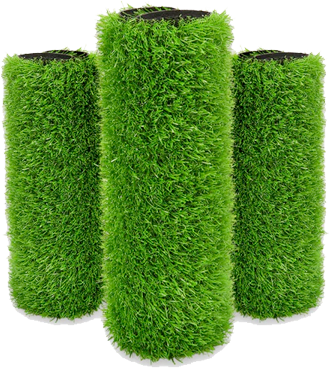Artificial grass isn’t just for homes and gardens; it’s now the standard choice for sports fields.
From community pitches to professional stadiums, synthetic turf delivers a reliable playing surface that performs in every season and under heavy use.
Sports like football, rugby, hockey, and tennis need surfaces that stay consistent, safe, and durable.
Natural grass struggles with mud, bald patches, and constant repairs, but artificial sports turf solves these issues with a system built for all-weather performance and long-lasting durability.
This guide will show you exactly what you need to know before choosing artificial grass for sports fields.
Here we’ll cover everything from top benefits, the best turf types for different sports, cost factors, maintenance tips, and will answer most asked questions related sports astro turf.
If you’re planning to buy artificial grass for a sports pitch, this guide will help you make the right decision with confidence.
- So… Is Artificial Grass Truly Safe for Children?
- What Makes Artificial Grass Safe for Children?
- How to Create a Child-Safe Artificial Grass Play Zone
- FAQs: What Every Parent Wants to Know
- Can kids play barefoot on artificial grass?
- Will artificial grass give my child rug burns?
- What if my child spills food or gets sick on the grass?
- Is it safe for babies and toddlers?
- Does artificial grass smell?
- Is it safe under the playground equipment?
- Will it help with allergies?
- Does artificial grass get too hot in summer?
Table of Contents
ToggleWhy Artificial Grass for Sports Fields?
The decision to invest in artificial grass for sports fields comes down to performance, reliability, and long-term savings.
Here’s why it’s become the go-to choice for clubs, schools, and professional venues:
1. Consistent Playing Surface in All Conditions
Natural grass is unpredictable.
Heavy rain turns pitches muddy and unsafe, while hot, dry weather leaves grass brittle and uneven.
All-weather sports turf solves this problem with a surface that looks and plays the same in January as it does in July.
Players get reliable ball roll, steady grip, and reduced risk of injury, regardless of the forecast.
2. Reduced Maintenance Compared to Natural Grass
Maintaining a grass pitch is expensive and time-consuming. Watering, mowing, reseeding, and constant repairs quickly add up.
With low-maintenance artificial turf, the work is minimal: occasional brushing to lift the fibres, clearing debris, and light cleaning.
That means less money spent on upkeep and more time the pitch is available for play.
3. Long-Lasting Durability Under Heavy Use
Sports facilities often deal with hundreds of hours of play each month. Natural turf wears down fast under this kind of pressure, leading to uneven patches that affect performance.
Durable sports turf is built to handle heavy foot traffic without losing its shape.
Whether it’s daily school matches, weekend tournaments, or intensive football training sessions, the surface stays strong.
4. Year-Round Availability
Perhaps the biggest advantage of synthetic turf is uninterrupted play.
With natural grass, matches often get cancelled due to waterlogging or poor field conditions.
With artificial sports grass, players and coaches can depend on a surface that’s always ready, saving schedules, avoiding cancellations, and ensuring facilities make the most of their investment.
Also Read: Why Should You Get Synthetic Turf?
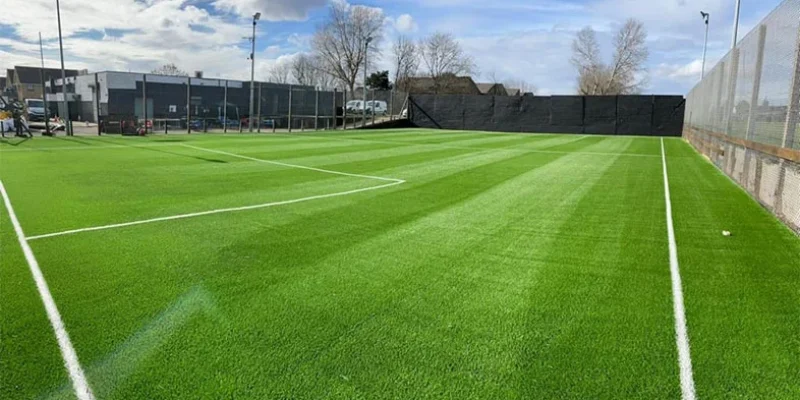
Key Benefits for Sports Use
When it comes to building or upgrading a sports pitch, choosing artificial sports turf brings clear, measurable benefits.
Unlike natural grass, which wears down quickly and requires constant upkeep, synthetic turf is engineered to perform under pressure and last for years with minimal maintenance.
Here are the key advantages:
Performance: Stable Traction and Shock Absorption
Every sport depends on predictable performance. A football turf or synthetic rugby turf must provide a strong grip for players while also absorbing impact to reduce strain on joints.
Modern shock-absorbent turf for sports is designed with advanced infill and underlay systems, giving athletes the right balance of stability and cushioning.
This ensures smoother ball roll in hockey, firm footing in rugby scrums, and reliable traction during fast football matches.
Durability: Handles High Foot Traffic and Equipment Use
Natural pitches can’t cope with the level of use demanded by schools, clubs, and professional facilities.
They quickly turn patchy and unsafe. In contrast, durable sports turf is built to handle heavy foot traffic from daily training sessions, tournaments, and community use without losing quality.
Whether it’s a multi-sport turf or a dedicated artificial football pitch, synthetic surfaces are engineered to maintain performance even after years of continuous play.
Safety: Even Surface, Fewer Muddy Patches, Better Injury Prevention
Uneven ground and muddy patches are common causes of injuries on natural grass. With artificial grass for sports fields, the surface stays level and reliable all year.
Players benefit from an even field that reduces slips, twists, and falls. The drainage design of all-weather sports turf also prevents waterlogging, so matches don’t get cancelled due to unsafe conditions.
For schools, playgrounds, and community spaces, this makes artificial turf for sports the safer and smarter option.
Cost-Efficiency: Long-Term Savings on Watering, Mowing, and Repairs
Installing synthetic turf may be a larger upfront investment compared to seeding a grass pitch, but the long-term savings are undeniable.
With low-maintenance artificial turf, there’s no need for watering, mowing, fertilising, or constant patch repairs.
Facilities save thousands each year on upkeep, while also maximising usage since pitches stay open in all seasons.
For buyers comparing the cost of artificial sports turf in London with natural alternatives, synthetic options consistently deliver a stronger return on investment.
Superior Lawn Sports Range (Available Options)
Choosing the right product is key to long-term performance, and specialist options make it easier to match turf to the sport.
At Superior Lawn, we offer a dedicated Astro Turf for sports range, designed to deliver maximum durability, safety, and playability. Each option is tailored to different sports and usage needs:
-
Astro 15mm Sports – £26.99
Best for hockey turf and ball-control sports where speed and precision matter. -
Astro 30mm Sports – £20.99
A versatile option for schools, playgrounds, and training pitches, designed to handle artificial grass for heavy foot traffic while remaining safe and easy to maintain. -
Astro 40mm Sports – £21.99
A balanced choice for football, tennis, and multi-sport turf, combining comfort and versatility. -
Astro 60mm Sports – £22.99
Perfect for rugby and football turf, offering durability, cushioning, and reliable grip for high-impact games.
These options are ideal for buyers looking to purchase artificial grass for sports fields in the UK, whether it’s for professional use, schools, or community projects.
Each turf is built to provide reliable performance, year-round availability, and a surface that stays strong season after season.
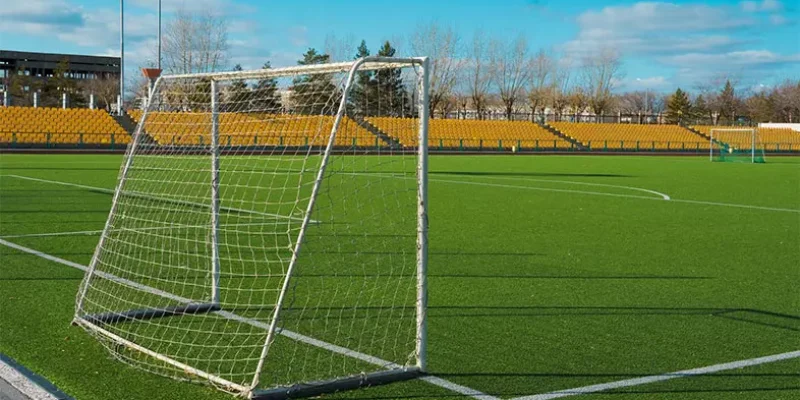
Choosing the Right Artificial Grass for Sports
Not all sports turf is the same.
The right choice depends on the sport being played, the level of use, and the type of facility.
Here are the main factors to consider when selecting artificial sports grass in London or anywhere else:
Pile Height & Density
The pile height of the turf directly affects gameplay. A shorter pile is perfect for sports that demand speed and ball control, like hockey turf, while a longer pile offers extra cushioning, ideal for football field turf and synthetic rugby turf.
Higher-density fibres also increase durability, making them better for competitive facilities with constant matches.
Infill Type
The infill provides weight, stability, and resilience. Options include sand, rubber crumb, or a hybrid mix.
For example, tennis court artificial grass usually needs less infill to keep the ball moving naturally, while an artificial football pitch benefits from rubber crumb for extra bounce and impact absorption.
The choice of infill will directly influence performance and player safety.
Drainage
Good drainage is essential for all-weather sports turf. Without it, pitches quickly become waterlogged and unsafe.
A professional synthetic turf installation for sports fields ensures the base layers allow rainwater to pass through efficiently, keeping the pitch usable even after heavy storms.
Shock Pads
Adding a shock pad beneath the turf creates a shock-absorbent turf for sports that improves player comfort and reduces the risk of injury.
These are especially important for rugby, football, and school pitches where falls and tackles are frequent.
What is the Best Artificial Grass for Sports Fields?
The “best” option depends on the sport and the level of play. Here’s how different types of artificial sports turf UK fit specific needs:
- Football and Rugby: A taller pile height (40–60mm) works best for these high-impact games. The surface needs to withstand tackles and sliding, making artificial football turf London and synthetic rugby turf the go-to solutions.
- Hockey: A shorter pile (15–30mm) gives smoother ball roll and faster gameplay. Professional clubs often prefer water-based or sand-dressed hockey turf for precision control.
- Tennis and Multi-Sport Areas: Medium pile heights (30–40mm) are ideal for a multi-sport turf that can handle tennis, netball, or training drills. A specialised sports grass carpet keeps the bounce consistent and surface durable.
- Schools and Playgrounds: For safe and practical play spaces, artificial turf for schools and playgrounds is designed with extra cushioning. These surfaces are soft, reliable, and built for artificial grass for heavy foot traffic.
If you’re looking to buy artificial grass for sports fields UK, focus on choosing a product that balances durability, safety, and cost-effectiveness.
Facilities that need frequent, year-round use will benefit most from all-weather sports turf with proper infill and shock pads.
Maintenance Tips for Sports Fields
One of the biggest advantages of modern astro turf for sports is how little upkeep it needs compared to natural grass.
But like any surface, regular care ensures it stays safe, clean, and long-lasting.
A few simple practices will keep your pitch at its best:
Regular Brushing
Using a stiff-bristle brush or power broom helps keep the fibres upright and evenly distributed. This is especially important on busy artificial football pitches and school training grounds where surface flattening is common.
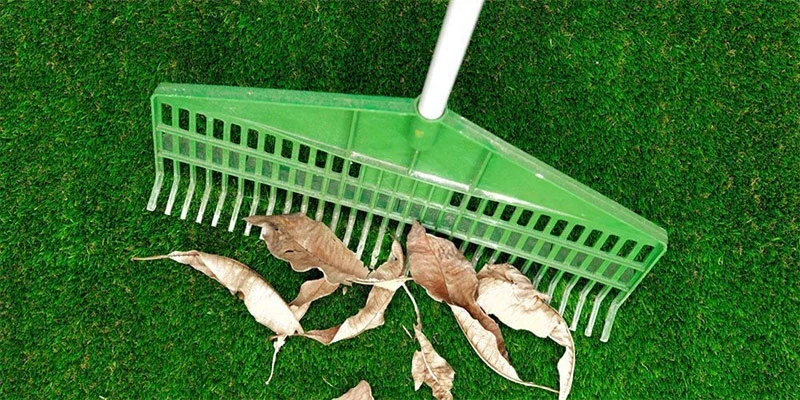
Remove Debris Promptly
Leaves, litter, and organic matter can block drainage and create slip hazards. Clearing these out regularly keeps the pitch fresh and avoids unwanted growth, particularly on community sports grass carpet installations.
Inspect Seams and Infill
Over time, high-use zones like goal mouths or mid-field areas can lose infill or show signs of wear. Checking seams and topping up material helps the synthetic surface stay consistent for play.
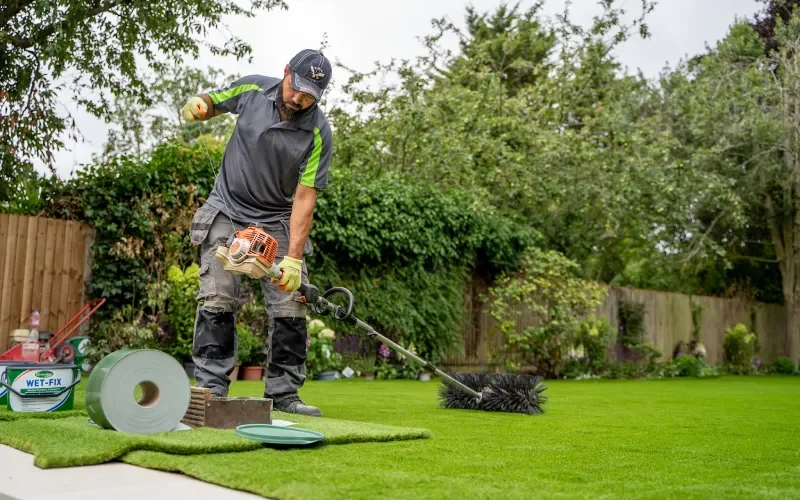
Deep Cleaning After Heavy Use
For tournaments or extended training sessions, a more thorough clean ensures hygiene and performance. A periodic rinse or professional deep clean keeps the field free of bacteria and odours, especially in multi-use or school settings.
With these habits, all-weather playing surfaces retain their quality and stay safe for players season after season.
Also Read: How To Clean Artificial Grass: The Only Guide You Need
Cost Considerations for Sports Artificial Grass
When weighing up natural grass versus man-made sports turf, the cost equation is about much more than just installation.
Here are the key factors to keep in mind:
- Initial Investment vs. Long-Term Savings: While laying down an artificial sports field surface requires a higher upfront spend, the savings add up quickly. No mowing, no fertilising, and no irrigation drastically cut annual costs.
- Ongoing Maintenance: Natural pitches demand constant upkeep, while engineered turf systems only need light brushing and occasional infill checks. Facilities save not only money, but also valuable time.
- Lifespan: A well-installed premium astro pitch can last well over a decade with proper care. When compared with the cycle of repairing or re-sodding natural grass, the long-term value is clear.
For buyers comparing the price of sports turf installation in the UK, synthetic options often prove more cost-effective over their lifespan than traditional grass fields.
Related Post: How Much Does Artificial Grass Cost in London? 2025
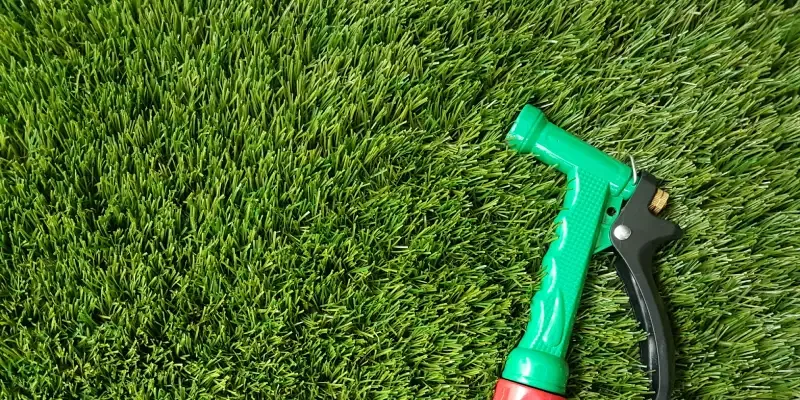
Is Artificial Turf Good for Football and Other Sports?
The short answer is yes. Modern synthetic turf has been developed specifically to meet the demands of multiple sports, making it a trusted choice for facilities worldwide.
For football, an artificial football pitch provides stable grip, reliable ball roll, and shock absorption to protect players during fast-paced matches.
Rugby benefits from synthetic rugby turf designed to handle tackles and scrums while reducing surface damage.
Hockey players enjoy consistent ball speed and smooth control on shorter-pile hockey turf, while tennis and netball courts rely on tennis court artificial grass that delivers bounce without compromising comfort.
Compared to natural grass, the advantages are clear:
- Performance: Pitches stay consistent year-round, unaffected by rain or heat.
- Safety: No muddy patches, bald spots, or uneven ground that cause injuries.
- Durability: Surfaces withstand daily play and heavy foot traffic without losing shape.
- Versatility: One installation of multi-sport turf can accommodate different games, training, and school activities.
This is why more clubs, schools, and communities are turning to artificial sports turf in the UK, it guarantees reliability, safety, and high performance no matter the season.
When to Call a Professional for Artificial Grass Care
At Superior Lawn, we make choosing the right sports surface simple. Book a FREE no-obligation survey and our team will:
- Visit your property to assess the space
- Recommend the best type of astro turf for sports based on your needs
- Provide a clear, detailed, and competitive quote
Whether you’re considering a new artificial football turf in London, a school play area, or a full multi-sport pitch, our experts ensure you get the perfect fit.
Conclusion
Artificial grass for sports fields is a game-changer. With the right surface, you get a pitch that’s always ready to play, no matter the weather or intensity of use.
By choosing high-quality field turf, installing it properly, and following a simple maintenance routine, facilities can enjoy reliable performance, safety, and cost savings for years to come.
From football and rugby to hockey and tennis, synthetic options offer a level playing field that natural grass simply can’t match.
If you’re ready to upgrade, Superior Lawn is here to deliver a durable, all-weather sports surface that performs season after season.
Frequently Asked Questions related to Artificial Grass
What type of artificial grass surface is used for sports?
Sports facilities typically use specialist sports turf designed for high durability, consistent traction, and impact absorption. Options vary by sport—shorter pile turf for hockey, medium pile for tennis and multi-use areas, and longer pile with infill for football and rugby.
How much is 2000 square feet of turf?
The cost of artificial sports turf in London depends on the pile height, infill system, and installation requirements. On average, installing 2000 sq ft could range from £20–£30 per square metre, including materials and professional fitting. A survey is the best way to get an accurate price for your project.
What is the best turf for sports fields?
The best turf depends on the sport. For example, football field turf and synthetic rugby turf need longer, cushioned fibres for impact, while hockey turf requires a shorter pile for smooth ball control. Multi-sport venues benefit from medium-pile systems that balance bounce, grip, and durability.
Is artificial grass good for a play area?
Yes. Artificial turf for schools and playgrounds is designed to be safe, soft, and low-maintenance. Many installations include shock pads underneath, providing extra cushioning to reduce injury risks from falls.
Can you play sports on artificial grass?
Absolutely. Today’s synthetic turf is specifically engineered for football, rugby, hockey, tennis, and more. It delivers consistent playability in all weather conditions, making it ideal for professional clubs, schools, and community pitches.
Which artificial grass is best for football?
The best artificial grass for football fields is a long-pile system (40–60mm) with rubber infill and shock pads for cushioning. This setup mimics natural grass while providing excellent durability and player safety.
What grass do they use on cricket fields?
Cricket often uses hybrid or short-pile sports turf in training areas for consistent bounce and easier maintenance. Some facilities prefer natural grass for main pitches, but synthetic options are increasingly popular for practice nets and indoor training surfaces.
How to choose the best artificial grass for a sports field?
When choosing artificial sports grass in the UK, consider the sport being played, the level of use, pile height, infill system, and drainage. For long-term reliability, it’s best to work with artificial grass suppliers for sports pitches who can assess your site and recommend the right product.


